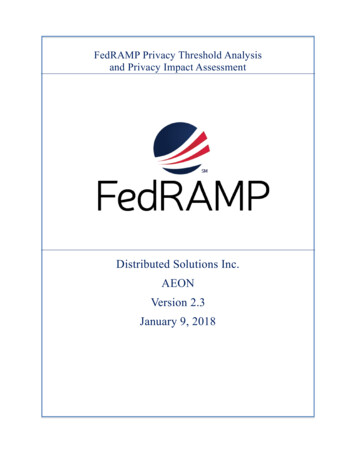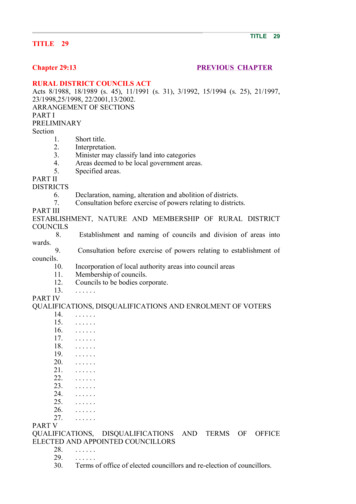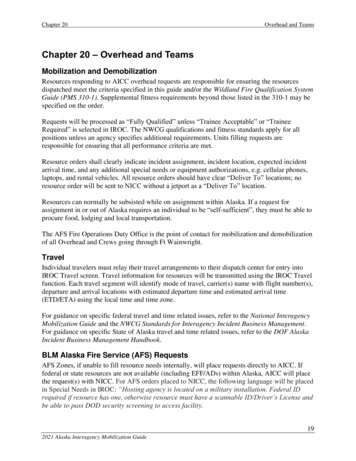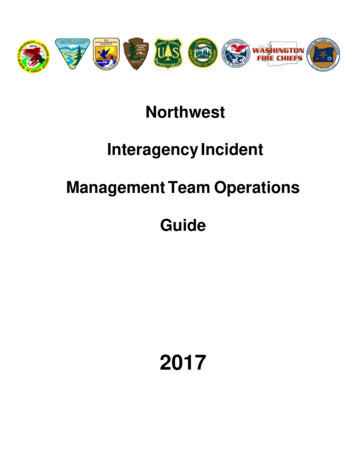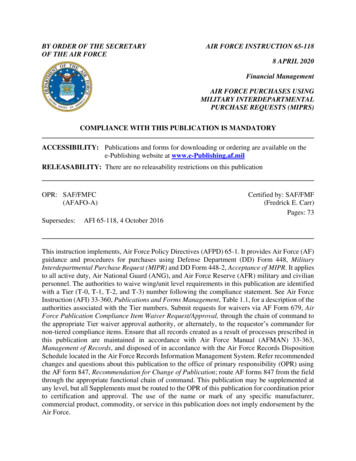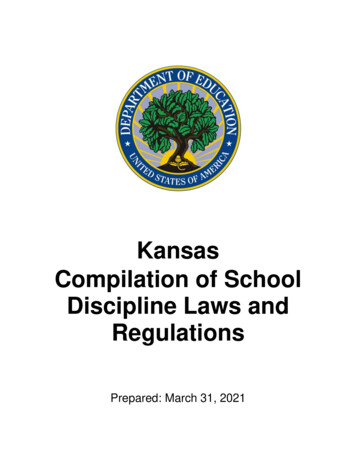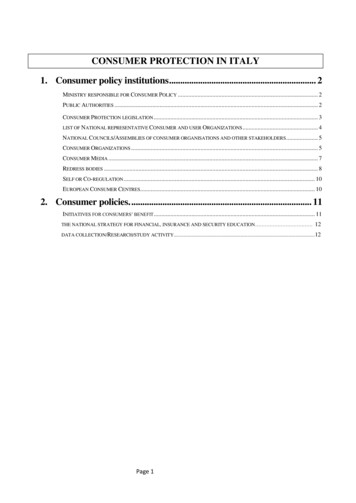
Transcription
Interagency ConsumerLaws and RegulationsFDPAFlood Disaster Protection ActThe National Flood Insurance Program (NFIP) is administered primarily under the NationalFlood Insurance Act of 1968 (1968 Act) and the Flood Disaster Protection Act of 1973(FDPA). 1The 1968 Act made federally subsidized flood insurance available to owners ofimproved real estate or mobile homes located in special flood hazard areas (SFHA) if theircommunity participates in the NFIP. The NFIP, administered by a department of the FederalEmergency Management Agency (FEMA) known as the Federal Insurance and MitigationAdministration (FIMA), makes federally backed flood insurance available to consumers throughNFIP Direct Program agents who deal directly with FEMA or through the Write Your OwnProgram (WYO), which allows consumers to purchase federal flood insurance from privateinsurance carriers. The NFIP aims to reduce the impact of flooding by providing affordableinsurance to property owners and by encouraging communities to adopt and enforce floodplainmanagement regulations. The FDPA requires federal financial regulatory agencies to adoptregulations prohibiting their regulated lending institutions from making, increasing, extending orrenewing a loan secured by improved real estate or a mobile home located or to be located in anSFHA in a community participating in the NFIP unless the property securing the loan is coveredby flood insurance. Flood insurance may be provided through the NFIP or through a privateinsurance carrier.Title V of the Riegle Community Development and Regulatory Improvement Act of 1994, 2which is called the National Flood Insurance Reform Act of 1994 (1994 Act), comprehensivelyrevised the Federal flood insurance statutes. The purpose of the 1994 Act was to increasecompliance with flood insurance requirements and participation in the NFIP in order to provideadditional income to the National Flood Insurance Fund and to decrease the financial burden offlooding on the Federal government, taxpayers, and flood victims. 3 The 1994 Act required thefederal financial regulatory agencies, the Board of Governors of the Federal Reserve System(FRB); the Federal Deposit Insurance Corporation (FDIC); the National Credit UnionAdministration (NCUA); and the Office of the Comptroller of the Currency (OCC) to revise theircurrent flood insurance regulations and brought lenders regulated by the Farm CreditAdministration (FCA) under the coverage of the Federal flood insurance statutes. The federalfinancial regulatory agencies and the FCA (collectively, the Agencies) jointly issued regulationson August 29, 1996 (61 FR 45684). 4The 1994 Act also made the flood insurance requirements directly applicable to the loanspurchased by the Federal National Mortgage Association (Fannie Mae) and the Federal HomeLoan Mortgage Corporation (Freddie Mac) and to agencies that provide government insurance or1These statutes are codified at 42 USC §4001-4129. FEMA administers the NFIP; its regulations implementing theNFIP appear at 44 CFR Parts 59-80.2Pub. L.103-325, Title V, 108 Stat. 2160, 2255-87 (September 23, 1994).3H.R. Conf. Rep. No. 652, 103d Cong. 2d Sess. 195 (1994). (Conference Report).4Agency regulations are codified at 12 CFR 22 (OCC); 12 CFR 208 (FRB); 12 CFR 339 (FDIC); 12 CFR 614(FCA); 12 CFR 760 (NCUA).July 2019FDPA 1
Interagency ConsumerLaws and RegulationsFDPAguarantees such as the Small Business Administration (SBA), Federal Housing Administration(FHA), and the Department of Veterans Affairs (VA).The mandatory flood insurance purchase requirements of the FDPA were again significantlyamended with the passage of the Biggert-Waters Flood Insurance Reform Act of 2012 (BiggertWaters Act) and the Homeowner Flood Insurance Affordability Act of 2014 (HFIAA). Thesestatutes made changes to the provisions pertaining to force placement of flood insurance;escrowing of flood insurance premiums and fees; exemptions to the mandatory flood insurancepurchase requirement; and civil money penalties. Moreover, a new provision mandating theacceptance of a private flood insurance policy meeting certain criteria as satisfaction of themandatory purchase requirement was added to the FDPA. The Agencies jointly issued rulesaddressing force placement, escrow, and the exemption to the mandatory purchase requirementfor detached structures on July 21, 2015 (80 FR 43215). The Agencies jointly issued rulesimplementing the private flood insurance provisions of the Biggert-Waters Act on February 20,2019 (84 FR 4953).Objectives of the FDPA: Provide flood insurance to owners of improved real estate located in SFHAs ofcommunities participating in the NFIP. Require communities to enact measures designed to reduce or avoid future flood losses asa condition for making federally subsidized flood insurance available. Require federal financial regulatory agencies to adopt regulations prohibiting theirregulated lending institutions from making, increasing, extending, or renewing a loansecured by improved real estate or a mobile home located or to be located in an SFHA ofa community participating in the NFIP, unless the property securing the loan is coveredby flood insurance. Require federal agencies, such as the FHA, SBA and the VA not to subsidize, insure, orguarantee any loan if the property securing the loan is in an SFHA of a community notparticipating in the NFIP.Structures Eligible for Flood Insurance Under the NFIPThe NFIP covers improved real property or mobile homes located or to be located in an areaidentified by FEMA as having special flood hazards. Generally, each insurable structurerequires a separate insurance policy. The following types of structures are eligible for coverage: Residential, industrial, commercial, and agricultural buildings that are walled and roofedstructures that are principally above ground. Buildings under construction where a development loan is made to construct insurableimprovements on the land. Insurance can be purchased to keep pace with the newconstruction.July 2019FDPA 2
Interagency ConsumerLaws and RegulationsFDPA Mobile homes that are affixed to a permanent site, including mobile homes that are partof a dealer’s inventory and affixed to permanent foundations. Condominiums. Co-operative buildings. Flood insurance coverage is also available for personal property and other insurablecontents contained in real property or mobile homes located in SFHAs. The propertymust be insured in order for the contents to be eligible.Structures Not Eligible for Flood Insurance Under the NFIP Unimproved land, bridges, dams, and roads. Mobile homes not affixed to a permanent site. Travel trailers and campers. Converted buses or vans. Buildings entirely in, on, or over water into which boats are floated. Buildings newly constructed or substantially improved on or after October 1, 1983, in anarea designated as an undeveloped coastal barrier with the Coastal Barrier ResourceSystem established by the Coastal Barrier Resources Act (Public Law 97-348).Flood Insurance Requirements for Lending InstitutionsBasic RequirementFlood insurance, either issued through the NFIP or from a private insurance provider, is requiredfor the term of the loan on buildings or mobile homes when an institution makes, increases,extends or renews a designated loan, meaning all three of the following factors are present: The loan (commercial or consumer) is secured by improved real estate or a mobile homethat is affixed to a permanent foundation (security property); The property securing the loan is located or will be located in an SFHA as identified byFEMA; and The community in which the property is located participates in the NFIP.The FDPA provides that a regulated lending institution may not make, increase, extend, or renewany loan secured by improved real property that is located in an SFHA unless the improved realproperty is covered by the minimum amount of flood insurance required by statute. Thisincludes situations where a security interest in improved real property is taken only “out of anabundance of caution.”July 2019FDPA 3
Interagency ConsumerLaws and RegulationsFDPANonparticipating CommunitiesAlthough a lender may make, increase, extend, or renew a loan in a nonparticipating community,a lender is still required to determine whether the security property is located in an SFHA and ifso, to notify the borrower. The lender must also notify the borrower that flood insurancecoverage under the NFIP is not available because the community does not participate in theNFIP. If the nonparticipating community has been identified for at least one year as containingan SFHA, properties located in the community will not be eligible for federal disaster reliefassistance in the event of a federally declared disaster.Because of the lack of NFIP flood insurance coverage and limited federal disaster assistanceavailable, a lender should carefully evaluate the risk involved in making such a loan. A lendermaking a loan in a nonparticipating community may want to require the purchase of privateflood insurance, if available. Also, a lender with significant lending in nonparticipatingcommunities should establish procedures to ensure that such loans do not constitute anunacceptably large portion of the financial institution’s loan portfolio.Federal agency lenders such as the FHA, the SBA and the VA will not subsidize, insure orguarantee any loan if the property securing the loan is in a SFHA of a community notparticipating in the NFIP. In addition, Freddie Mac and Fannie Mae will not purchase mortgagessecured by improved properties located in SFHAs in nonparticipating communities.Special Situation—Table Funded LoansIn the typical table funding situation, the party providing the funding reviews and approves thecredit standing of the borrower and issues a commitment to the broker or dealer to purchase theloan at the time the loan is originated. Frequently, all loan documentation and other statutorilymandated notices are supplied by the party providing the funding, rather than the broker ordealer. The funding party provides the original funding “at the table” when the broker or dealerand the borrower close the loan. Concurrent with the loan closing, the funding party acquires theloan from the broker or dealer.For flood hazard determination purposes, the substance of the table funded transaction shouldcontrol and the typical table funded transaction should be considered a loan made, rather thanpurchased, by the entity that actually supplies the funds. Regulated institutions that provide tablefunding to close loans originated by a mortgage broker or mobile home dealer will be consideredto be “making” a loan for purposes of the flood insurance requirements.Treating table funded loans as loans made by the funding entity need not result in duplication offlood hazard determinations and borrower notices. The funding entity may delegate to thebroker or dealer originating the transaction the responsibility for fulfilling the flood insurancerequirements or may otherwise divide the responsibilities with the broker or dealer.Exemptions to the Purchase RequirementThe flood insurance purchase requirement does not apply to the following three loan situations:July 2019FDPA 4
Interagency ConsumerLaws and RegulationsFDPA Loans on state-owned property covered under an adequate policy of self-insurancesatisfactory to the Administrator of FEMA. The Administrator will periodically publish alist of state property falling within this exemption. Loans with an original principal balance of 5,000 or less, and having an originalrepayment term of one year or less. Any structure that is a part of any residential property but is detached from the primaryresidential structure of such property and does not serve as a residence. A structure that is part of a residential property is a structure used primarily forpersonal, family, or household purposes, and not used primarily for agricultural,commercial, industrial, or other business purposes. It is detached from the primaryresidential structure if it is not joined by any structural connection to that structure. Whether a structure serves as a residence is based on the institution’s good faithdetermination that the structure is intended for residential use or actually used as aresidence, which generally includes sleeping, bathroom, or kitchen facilities, but notnecessarily all three.Amount of Flood Insurance RequiredThe minimum amount of flood insurance required must be at least equal to the lesser of theoutstanding principal balance of the loan, the maximum amount available under the NFIP for thetype of structure, or the insurable value of the property. Flood insurance coverage under theNFIP is limited to the building or mobile home and any personal property that secures the loanand not the land itself.The limits of coverage for flood policies are: 250,000 for residential property structures and 100,000 for personal contents. 500,000 for non-residential structures and 500,000 for contents. 500,000 for non-condominium residential buildings of five units or greater and 100,000 for personal contents. 5Acceptance of Private Insurance PoliciesA regulated lending institution is required to accept a private insurance policy to satisfy the floodinsurance purchase requirement if the policy meets the definition of “private flood insurance” asset forth in the regulation (mandatory acceptance).A regulated lending institution may choose to accept certain flood insurance policies that do notmeet the definition of “private flood insurance” set forth in the regulation if the policy meetscertain criteria (discretionary acceptance). A regulated lending institution may also exercise its5This amount was increased from 250,000 to 500,000 as of June 1, 2014.July 2019FDPA 5
Interagency ConsumerLaws and RegulationsFDPAdiscretion to accept certain plans providing flood coverage issued by “mutual aid societies”provided that certain criteria are met.Mandatory Acceptance Under the regulation, “private flood insurance” means an insurance policy that: is issuedby an insurance company that is licensed, admitted or otherwise approved to engage inthe business of insurance by the insurance regulator of the State or jurisdiction in whichthe property to be insured is located, or is recognized, or not disapproved as a surplus lines insurer by the insurance regulator ofthe State or jurisdiction in which the property to be insured is located in the case of apolicy of difference in conditions, multiple peril, all risk, or other blanket coverageinsuring nonresidential commercial property; provides flood insurance coverage that is at least as broad as the coverage provided underthe NFIP’s Standard Flood Insurance Policy (SFIP) for the same type of property,including when considering deductibles, exclusions and conditions offered by the insurer;to be at least as broad as the coverage provided under an SFIP, the policy must at aminimum: define the term “flood” to include the events defined as “flood” in an SFIP; contain the coverage specified in an SFIP, including that relating to building propertycoverage; personal property coverage; other coverages; and increased cost ofcompliance coverage; contain deductibles no higher than the specified maximum, and include similar nonapplicability provisions, as under an SFIP, for any total policy coverage amount up tothe maximum available under the NFIP at the time the policy is provided to theinstitution; provide coverage for direct physical loss caused by a flood and may only excludeother causes of loss that are excluded in an SFIP. Any exclusions other than those inan SFIP may pertain only to coverage that is in addition to the amount and type ofcoverage that could be provided by an SFIP or have the effect of providing broadercoverage to the policyholder; and not contain conditions that narrow the coverage provided in an SFIP; provides that the insurer will give written notice 45 days before cancellation or nonrenewal of flood insurance coverage to the insured and the regulated lending institution,or servicer acting on its behalf; includes information about the availability of flood insurance coverage under the NFIP;July 2019FDPA 6
Interagency ConsumerLaws and RegulationsFDPA includes a mortgage interest clause similar to the clause contained in an SFIP; includes aprovision requiring an insured to file suit not later than one year after the date of a writtendenial of all or part of a claim under the policy; and contains cancellation provisions that are as restrictive as the provisions in an SFIP.For purposes of the definition of “private flood insurance,” the SFIP is the policy that is in effectas of the date the private flood insurance policy is provided to the regulated lending institution.The SFIP is available on the FEMA website: am/standard-flood-insurance-policy-forms. The regulation includes a compliance aidprovision to help a regulated lending institution determine whether a flood insurance policymeets the definition of “private flood insurance” and must be accepted under the regulation. Aregulated lending institution may determine that a policy meets the definition of “private floodinsurance” without further review of the policy if the policy or an endorsement to the policystates: “This policy meets the definition of private flood insurance contained in 42 U.S.C.4012a(b)(7) and the corresponding regulation. ”Discretionary AcceptanceUnder the regulation, a regulated lending institution may, at its discretion, accept a floodinsurance policy issued by a private insurer, even if the policy does not meet the statutory andregulatory definition of “private flood insurance” as set forth above. A regulated lendinginstitution, may, at its discretion, accept a private flood insurance policy in satisfaction of theflood insurance purchase requirement if the policy: provides coverage in the amount as required under the regulation; is issued by an insurer that is licensed, admitted or otherwise approved to engage in thebusiness of insurance by the insurance regulator of the State or jurisdiction in which theproperty to be insured is located; or in the case of a policy of difference in conditions,multiple peril, all risk or other blanket coverage insuring nonresidential commercialproperty, is issued by a surplus lines insurer recognized, or not disapproved by theinsurance regulator of the State or jurisdiction where the property to be insured is located; covers both the mortgagor(s) and the mortgagee(s) as loss payees, except in the case of apolicy that is provided by a condominium association, cooperative, homeownersassociation, or other applicable group and for which the premium is paid by thecondominium association, cooperative, homeowners association, or other applicablegroup as a common expense; and provides sufficient protection of the designated loan, consistent with general safety andsoundness principles, and the regulated lending institution documents its conclusionregarding sufficiency of the protection of the loan in writing.Some factors that a regulated lending institution could consider in determining whether a floodinsurance policy provides sufficient protection of a loan include:July 2019FDPA 7
Interagency ConsumerLaws and RegulationsFDPA whether the flood insurance policy’s deductibles are reasonable based on the borrower’sfinancial condition; whether the insurer provides adequate notice of cancellation to the mortgagor andmortgagee to ensure timely force placement of flood insurance, if necessary; whether the terms and conditions of the flood insurance policy with respect to paymentper occurrence or per loss and aggregate limits are adequate to protect the regulatedlending institution’s interest in the collateral; whether the flood insurance policy complies with applicable State insurance laws; and whether the private insurance company has the financial solvency, strength, and ability tosatisfy claims.Plans Provided by Mutual Aid SocietiesThe regulation defines a “mutual aid society” as an organization: (1) whose members share acommon religious, charitable, educational, or fraternal bond; (2) that covers losses caused bydamage to members’ property pursuant to an agreement, including damages caused by flooding,in accordance with this common bond; and (3) that has a demonstrated history of fulfilling theterms of agreements to cover losses to members’ property caused by flooding. A regulatedlending institution may, at its discretion, accept a plan issued by a mutual aid society insatisfaction of the flood insurance purchase requirement, if the following criteria are met: the regulated lending institution’s primary Federal supervisory agency has determinedthat such plans qualify as flood insurance for purposes of the Federal flood insurancestatute; the plan provides coverage in the amount required under the regulation; the plan covers both the mortgagor(s) and the mortgagee(s) as loss payees; and the plan provides sufficient protection of the designated loan, consistent with generalsafety and soundness principles, and the regulated lending institution documents itsconclusion regarding sufficiency of the protection of the loan in writing.Waiting PeriodNFIP flood insurance policies that are not issued in conjunction with the making, increasing,extending or renewing of a loan have a 30-day waiting period. The congressional intent behindthis requirement was to prevent the purchase of flood insurance (and any direct loss to the U.S.government) in times of imminent loss. However, if the initial purchase of flood insurance ismade during the 13-month period following revision or update of a Flood Insurance Rate Mapfor the community, there is a one-day waiting period.July 2019FDPA 8
Interagency ConsumerLaws and RegulationsFDPAThere is no waiting period when an additional amount of NFIP insurance is required inconnection with the making, increasing, extending or renewing of a loan, such as a secondmortgage, home equity loan, or refinancing.Special Situations—Second Mortgages/Home Equity LoansBoth second mortgages and home equity loans are transactions that may be subject to themandatory purchase requirements of the FDPA. Because only one NFIP flood insurance policycan be issued on a building, an institution should not request a new NFIP flood insurance policyif one already exists. Instead, the institution should have the borrower contact the insuranceagent: To inform the agent of the intention to obtain a loan involving a subordinate lien To obtain verification of the existence of a flood insurance policy, and To check whether the amount of insurance covers all loan amounts.After obtaining this information, the insurance agent should increase the amount of NFIPcoverage if necessary and issue an endorsement that will reflect the institution as a lien holder.As an alternative, the borrower may also consider obtaining a private flood insurance policy inthe proper amount.For loans with approved lines of credit to be used in the future, it may be difficult to calculate theamount of insurance for the loan since the borrower will be drawing down differing amounts onthe line at different times. If there is no policy on the collateral, the borrower must, at aminimum, obtain a policy as a requirement for drawing on the line. As a matter of administrativeconvenience to ensure compliance with the requirements, an institution may take the followingalternative approaches: As part of its procedures, an institution should review its records periodically so that asdraws are made against the line or repayments made to the account, the appropriateamount of insurance coverage can be maintained; or Upon origination, require the purchase of flood insurance for the total amount of the line,the value of the improved property or the maximum amount of flood insurance coverageavailable, whichever is less.Special Situations—Condominium PoliciesFEMA’s condominium master policy is called a Residential Condominium Building AssociationPolicy (RCBAP). The RCBAP covers both the common and individually owned buildingelements within the units, improvements within the units, and contents owned in common ifcontents coverage is purchased. The maximum amount of building flood insurance coverage thatcan be purchased under an RCBAP is either 100 percent of the replacement cost value of theJuly 2019FDPA 9
Interagency ConsumerLaws and RegulationsFDPAbuilding, or the total number of units in the condominium building times 250,000, whichever isless.An institution must ensure that the minimum amount of flood insurance covering thecondominium unit is the lesser of: the outstanding principal balance of the loan, or the maximum amount of insurance available under the NFIP which is the lesser of:o the maximum limit available for the residential condominium unit, oro the insurable value allocated to the residential condominium unit which is thereplacement cost value of the condominium building divided by the number of units.Therefore, an institution must require a borrower whose loan is secured by a residentialcondominium unit to either: Ensure the condominium owners association has purchased an RCBAP, or other floodinsurance policy, covering either 100 percent of the replacement cost value of thebuilding, or the total number of units in the condominium building times 250,000,whichever is less; or Obtain a Dwelling Policy if the condominium owners association has not purchased floodinsurance as described above or if that coverage is less than either 100 percent of thereplacement cost value of the building or the total number of units in the condominiumbuilding times 250,000, whichever is less. The amount of coverage under a DwellingPolicy required to be purchased by the individual unit owner would be the differencebetween the condominium policy’s coverage allocated to that unit and the mandatoryflood insurance purchase requirements discussed above.For instance, the maximum amount of coverage on a 50-unit condominium building would be 12,500,000 ( 250,000 x 50). If the replacement cost value of the building was 10,000,000, thecondominium association could purchase a policy of 10,000,000. This amount of insurancewould meet the requirements of the regulations for any individual unit insurance requirement inthe condominium.Non-residential condominium buildings are not eligible for coverage under the RCBAP. TheNFIP offers a maximum amount of building coverage up to 500,000 for these buildings and 500,000 for commonly owned contents. Under the NFIP, the owner of a non-residentialcondominium unit within a non-residential condominium building may purchase only contentscoverage for that unit. Building coverage may not be purchased in the name of the unit owner.The maximum allowable contents coverage for non-residential owners is 500,000.July 2019FDPA 10
Interagency ConsumerLaws and RegulationsFDPAOther Special Situations Multiple Structures— Multiple structures that secure a loan located in an SFHA musteach be covered by flood insurance, even though the value of one structure may besufficient to cover the loan amount. Under the NFIP, FEMA generally requires onepolicy per building, but also permits borrowers to insure non-residential buildings usingone policy with a schedule separately listing each building. This coverage alternative maybe especially useful for loans secured by agricultural properties and improvements. Other Real Estate Owned— An institution with other real estate owned (OREO) inSFHAs should, as a prudent practice, purchase flood insurance policies on its OREOproperty, although it is not required to do so by the regulations.Escrow RequirementsThe regulations require the escrowing of flood insurance premiums and fees for designated loanssecured by residential improved real estate or a mobile home made, increased, renewed, orextended on or after January 1, 2016. In addition, institutions must offer and make available theoption to escrow for flood insurance premiums and fees to borrowers with designated loanssecured by residential improved real estate or a mobile home outstanding as of January 1, 2016.The escrow provisions are designed to improve compliance with flood insurance requirements byensuring that borrowers with designated loans secured by residential improved real estate or amobile home set aside funds to maintain flood insurance for the life of the loan.While the escrow requirement pertains generally to any designated loan secured by residentialimproved real estate or a mobile home, there are two types of exceptions: a small lenderexception and a loan-type exception. The regulation provides that an institution is not required toescrow if it has total assets of less than 1 billion as of December 31 of either of the two priorcalendar years and, as of July 6, 2012: The institution was not required by Federal or State law to escrow taxes, insurancepremiums, fees, or any other charges for the term of the loan; and The institution did not have a policy of uniformly and consistently escrowing the same.If an excepted institution no longer qualifies for the exception because its assets exceeded thethreshold for two consecutive calendar year ends, it must begin escrowing for any designatedloan secured by residential improved real estate or a mobile home made, increased, extended, orrenewed on or after July 1 of the first calendar year of changed status. If a financial institutionprovides escrow accounts only upon requests from borrowers, this does not constitute a uniformor consistent policy of requiring escrows.In addition, the escrow requirement does not apply to the following types of loans: Extensions of credit primarily for business, commercial, or agricultural purposes even ifsecured by residential real estate;July 2019FDPA 11
Interagency
The loan (commercial or consumer) is secured by improved real estate or a mobile home that is affixed to a permanent foundation (security property); The property securing the loan is located or will be located in an SFHA as identified by FEMA; and The community in which the property is located participates in the NFIP.

